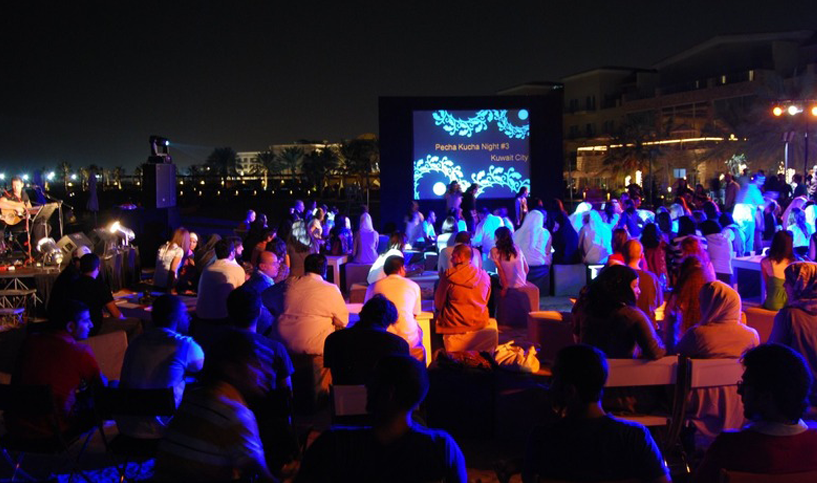By Nada Faris
Thanks to a splendid array of organizers such as Dr. Aseel Al-Ragem, KASA, KYNN and Element 8, the third Pecha Kucha Night’s setting was more magical than any fairytale’s. Guests were greeted at the Mövenpick Hotel’s door by a cheerful staff employee who pointed us to the direction of the beach. Long burning torches stood at either side of the patio’s pathway directing us to Pecha Kucha Night’s congregation. The congregation gathered over ottomans, beach tables, deck chairs and even mats. Some were formally dressed and others walked on the sand with naked feet. Once we were among them, it seemed that we were all part of a vast network of connections. We met with friends, family and acquaintances who contributed to the place’s vibrancy, with hugs, kisses, laughter, and the desire to cheer on their friends and loved ones.
Refreshments were offered as we settled down on our ottomans. That is when we realized that the evening’s ambiance was enhanced by the DJ’s choice of music and the perfect positions of moving lights. But I was roused from my reverie when Dr. Aseel Al-Ragem commenced the evening with a succinct introduction about the nature of Pecha Kucha Night. Pronounced “pCHA kCHA” instead of “peeecha kooocha,” the term reflects the sound of chit-chat in the Japanese language. The event itself operates as a stage for critical thoughts as well as creative visions. This takes place through a unified format of presentation, where every speaker is permitted only twenty images in an automatic slideshow and twenty seconds of explanations over every image.
The first presenter was Farah Bahbahani, a graphic designer who expedited our understanding of how design became a way of life. With sheer eloquence, proper pacing and brilliant content, Farah aimed to show how simple mundane data could be transformed into sensational graphics. She concentrated on Arabic calligraphy and celebrated our heritage and culture by making calligraphy more accessible to non-Arabic readers. Bahbahani has showcased her typography in different galleries such as Dubai and Beijing. She even published a book entitled The Conference of the Birds.
And as it so often happens in Pecha Kucha Night, the second presenter’s style and content highlighted the convention’s accumulation of various flairs. For instance, while Bahbahani was professional and academic, Ismael Abedin’s Streets of Kuwait intended to delight and entertain the audiences. His beautiful accent, mixed with a series of premeditated jokes lightened the atmosphere. Abedin’s an interior designer and photographer with a message behind his humor. He believes Kuwait is beautiful, but we need to keep it clean.
I wasn’t quite sure where Dana Al-Hasan, the third presenter, was going with her Electric City. She hopped from topic to topic and left the former incomplete. For example, she began with technology, and explained how it enabled our understanding of the city to change from a static geographical region to cross-geographical networks. Before she resolved the topic, we were shown two contrasting images: the first was of a city that was bare and lifeless, and the other was of another city that “never slept.” Again, the concept skipped onto the nature of the electrical city’s intricate connection to the present and its opposition to Utopia. Then we were told that mass production was unavoidable, but that theory was espoused by a defense of the individual. Stranger compilations of images and concepts followed: the internet as a constellation of stars, Friday markets, reconstructing a Macy’s store into an Opera house, and the question of locality. Al-Hasan concluded with two statements. The first was a belief that it is a crime to keep any space bare—everything must be designed. And finally, that children must have the chance to work with technology from a very young age.
The fourth presenter is Bazaar’s very own Loaay Ahmad, a founder of Knights Capital, a digital artist, marketing consultant, and strategic expert. His presentation was divided into three parts. The first section dealt with the way companies targeted consumers. He explored the question: “Should the company change its target audience for maximum profit?” His final caveat for businesses was to withstand competitive intimidation. Ahmad’s second section concentrated on the reduction of junior staff members that resulted from the credit crunch. His conclusion was that the CEOs themselves were the ones that aught to have been fired. Ahmad’s final section analyses the advantages of bringing culture into a business firm. Culture, for Ahmad, is to reconstruct the workplace’s environment from hardcore professionalism to comfort and entertainment. This includes adding pool tables in the office or conducting meetings in restaurants. Ahmad’s closing words were that synergy in business offered a better vibe through culture, which leads to good fun and better profit.
The evening was then intermitted for thirty minutes as Chad Sycamore and Drew Jones played live for the crowd. Sycamore and Jones are members of The Maplejacks, who are celebrated as the “Middle East’s premier party band.” Although they are based in Dubai, they played in various places such as Europe, Australasia, the Far East and the Middle East. On Pecha Kucha Night, they played covers from a lineup of songs they had prepared as well as special requests. These included, The Eagles’ “Hotel California,” REM’s “Losing my Religion,” Bob Dylan’s “Knocking on Heaven’s Door,” and Michael Jackson’s “Billie Jean.”
The evening resumed again with Abd Al-Rahman Al-Terkait, an amateur photographer. Al-Terkait spoke in Arabic and presented a series of heartbreaking images of misfortunate children in different parts of Africa. For instance, he photographed a child who lives in a car’s tire, another that lives in a bus stop and one who has been orphaned when the tsunami killed her parents. While Al-Terkait’s photographs and his choice of audio accompaniment did break the audience’s hearts, he failed to relay any critical thought or action. His entire premise was just to distribute these images to make us “imagine they were our children.” I appreciated the question that was directed to him at the end of the evening when someone asked him if he ever thought of publishing and selling these same photos in order to give the profit to the children. Unfortunately, Al-Terkait responded, “No. I don’t think of selling them. I just want to show them.”
Fareed Abdal, an architecture student, came afterward and discussed the importance of letters as a means of inner contemplation. Like Dana Al-Hasan however, his presentation was somewhat disjointed. The audience was left to infer from a series of phrases what the speaker meant at a certain point. For example, “Go beyond mind and personal construct,” referred to writing’s ability to offer perspectives beyond the institutionally established thoughts. Abdal mentions his interest in the fourteen marvels in the Qur’anic script and the thirteen Chinese symbols that reflected life but he did not present either. He assures the audience that the state of “no mind” enables one to “come back fresh with a child innocence,” and that it might “construct, deconstruct, and reconstruct.” The problem I had with such a statement was its sweeping usage of terms that were distinctive. For instance, deconstruction is not interchangeable with reconstruction.
It took the last speaker to set the cherry on the top of a delectable evening. This speaker was none other than the popular Teddy B. The famous Teddy discussed (with verbal agility) his life in the public eye, his desire to provide aid for charities and good causes.
Pecha Kucha Night invites all sorts of people with creative visions and critical thoughts. If you think you might be one of them, why don’t you try out for the next one? The fourth Pecha Kucha Night will take place sometime during December.
For more information about the author, please visit www.nadafaris.com.








